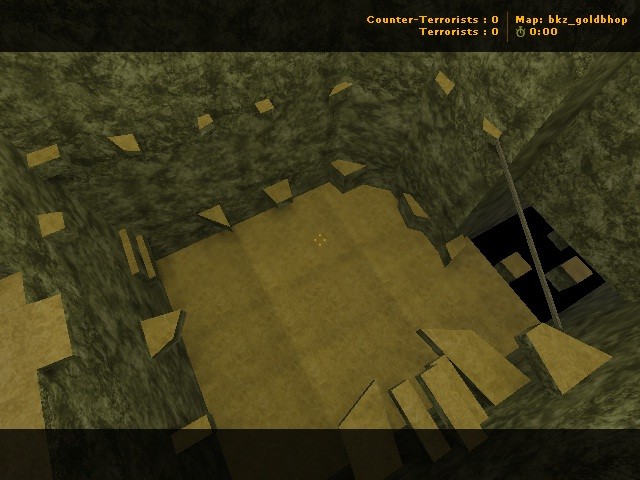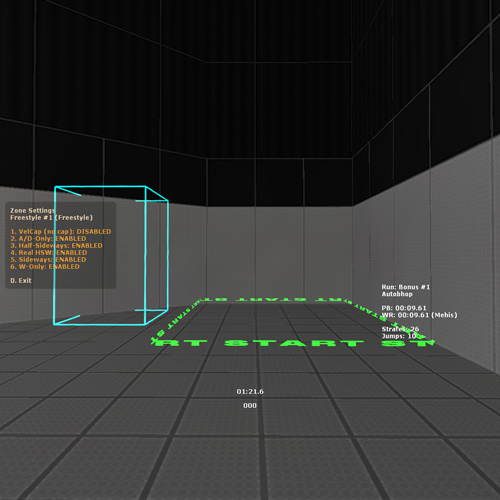Bhop history
What is Bunnyhop?
Bunnyhop is a physics exploit that has existed since the late 90's in various videogames. The implementation is a little different in each game, but the main goal remains the same: Getting places faster. Due to the nature of this exploit, it quickly became a popular technique for speedrunners and skilled players to utilize.
Some of the earliest games where bunnyhopping was discovered include Quake, Unreal tournament 99, and Half Life. It didn't become a standalone game mode until the early 2000s when a user by the named of Kreedz came up with a standalone mod for HL1 called Kreedzmod (which we still use as a term today, shortened to "KZ".) KZ maps often focused around what is now called "climb" due to most of them requiring you to scale them vertically. The first videos of kreedz on youtube start popping up around 2006, though this doesn't necessarily mean it wasn't around before then.

CS:S Bunnyhop
While you might be able to find a map released in 2005 for Counter-Strike: Source that could technically be considered bhop, bunnyhop for CS:S did not become its own thing until around 2007. By this time, there was a popular mod sharing site called FPSbanana (now Gamebanana) where users could share their work in the appropriate game section, categorized by map type. And thus, the CS:S bhop section was born.
The first major bunnyhop server on CS:S was probably Aoki's server in 2009. Over time, it saw thousands of players, and the standardization of many practices that are still used to this day, such as plugin-based timers and anticheats. This server also saw the release of some of the recognizable classics such as bhop_exodus, bhop_monsterjam, and kz_bhop_yonkoma. Other servers around this time period included Teamquick, THC, Intox, box n prox, HG, sG.

Autobhop
What is autobhop? To understand autobhop, we must first address the issues with Scrolling.
Scrolling is a mechanic for bhop in which players bind their jump command to mousewheel in order to spam the jump command in rapid succession to more accurately land "perfs". "Perf" refers to a perfect jump, meaning you jumped on the same tick that you landed on the ground. Perfs give the most possible speed and chaining perfs lets you rapidly gain speed while playing on scroll which is the game's default mode.
The problem with scroll lies in the engine itself. The jump command issues not one, but two commands every time it is used: +jump, and -jump. You can only be doing one of these per tick, so it is not possible to land a perf every single time, leading many players to refer to scrolling as "rng". In an attempt to remove rng from the gamemode, developers introduced a new style of scrolling called Easybhop. Easybhop made every jump the same height as your first jump, negating the game's native stamina penalty for chaining jumps. It also made the window for landing a perfect jump much higher.
Autobhop is a plugin introduced around that same time that allows the player to hold the spacebar down to automatically chain perfect jumps with no extra effort, allowing for the maximum possible speed from chaining jumps (before other factors, such as tickrate, airaccelerate, and strafe mechanics), are applied. This plugin was arguably the most controversial and divisive among the playerbase, as many did not agree with this change. The plugin was limited to a select few servers and received a lot of backlash from those who preferred scrolling. It is incredibly difficult to pinpoint the exact conception date of these plugins, but there are some references online such as this post which credit a user named "blodia" for the creation of Easybhop, and this page suggesting that autobhop has been around since at least 2009.
Autobhop allowed for the easy access to much higher values of speed and by extension new routes for all of the maps that existed at the time. It also pushed mappers to take on a different mapping style, which further divided the community, as there were now maps which were not easily possible on scroll.
Timer History
What is a timer? It's almost exactly what it sounds like. A timer is a server-sided plugin that counts and records how long it took you to get to the end of a map from the starting point.
While it's incredibly hard to pinpoint the first example of a timer plugin, references can be found online of people using them as far back as 2009 at least, for CS:S, and probably even earlier for KZ-Mod.
Some of the earliest publicly available timers for CS:S included H!ghvoltage and Zipcore's timers. While they did not have a vast range of functionality, they did exactly what they needed to do, and featured
leaderboard lookups to see other players times. 2013 saw the release of Blacky's Timer, which would become the main timer for the foreseeable future. It boasted many unique features over the other available timers at the time, such as: Replay functionality, Checkpoints, Bonuses, and Multiple styles (W-only, SW, and eventually HSW -- and more!)

Blacky's Timer was originally exclusive to a server called Chaotic Warfare (predominantly known as CW), where many new features made their debut as the timer development progressed.
Eventually, blacky himself made the decision to sell the timer to other server owners, and many people bought it for around 300$ (with all functions, including BASH anticheat.)
Some of the first few servers to acquire the prestigious timer were: Slice bhop, sG, Titanclan, and AG. blacky continued timer development, but for CS:GO exclusively.
Around 2017, blacky ported his 2.0 version of the timer from CS:GO to CS:S. It was the first time that CS:S players ever got unrestricted access to speedrun tools, due to this timer featuring a "TAS" style.
The TAS style allowed you to rewind your timer and set a timescale value, so that you could use slow motion and rewind any mistake you made. In this same year, a player by the name of shavit was also developing a timer, which
would eventually become a major competitor to bTimes. shavit's timer also included a style for tool assisted runs, however instead of rewinding, it allowed you to save your position with a checkpoint while saving your current time.
Players discovered that these tools were more easily accessible while being painless to use. This, coupled with the fact that it is open-sourced and still actively being developed by helpful devs,
was just one of many features that helped shavit overtake the other timers and have a home on nearly every server used even today.





